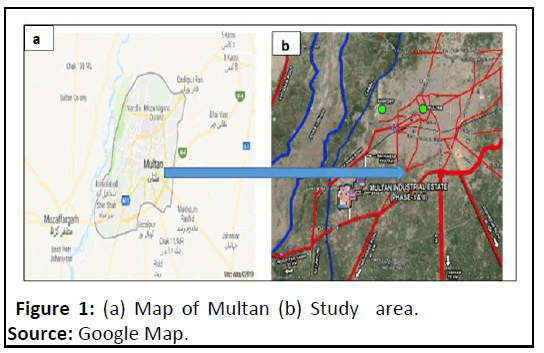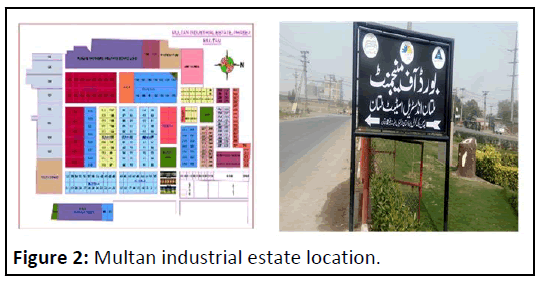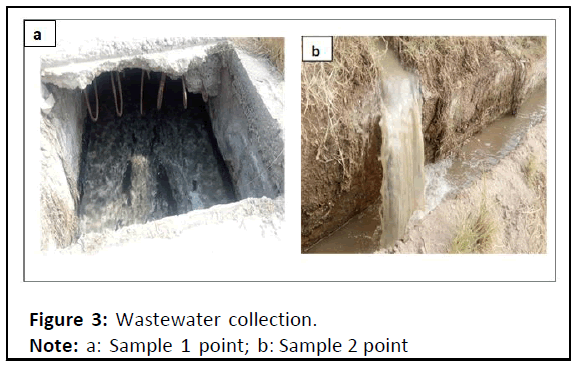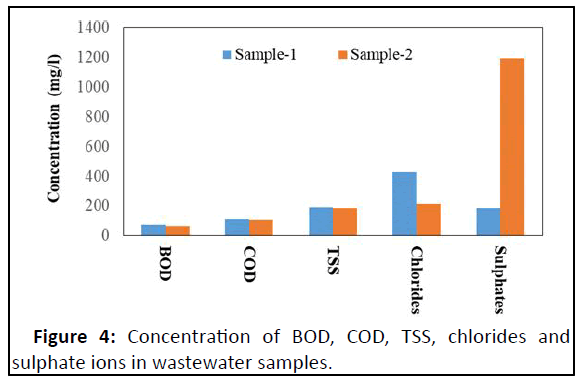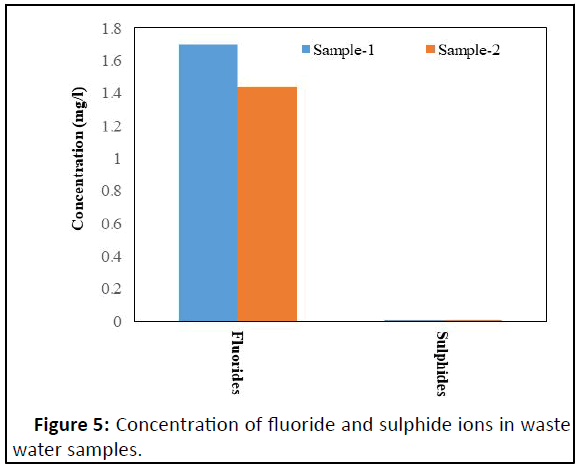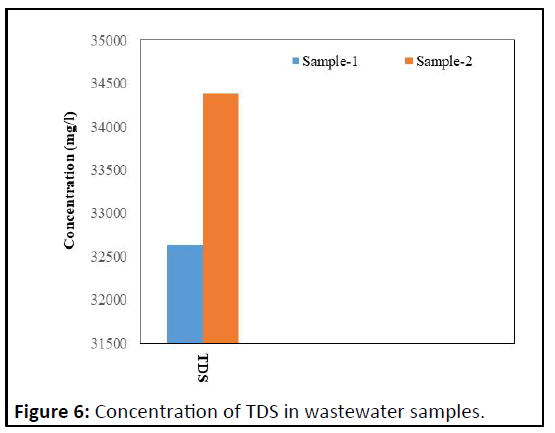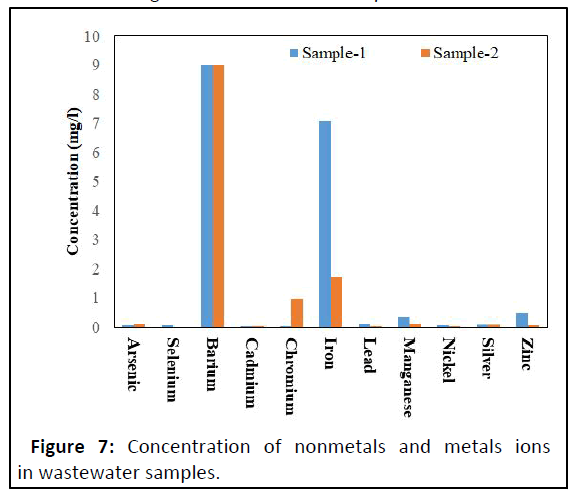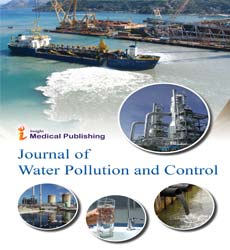Assessment of Wastewater Pollution of Industrial Estate Multan (Pakistan)
Rizwan Ullah Khan1*, Muhammad Hamayun1, Ataf Ali Altaf2, Samia Kausar1, Zobia Razzaq1 and Tehzeen Javid1
1Department of Chemistry, University of Gujrat, Gujrat, Pakistan
2Department of Chemistry, University of Okara, Okara, Pakistan
*Corresponding Author:
- Rizwan Ullah Khan
Department of Chemistry,
University of Gujrat,
Gujrat,
Pakistan,
Tel: 92513171173220;
E-mail: rizwan06_khan@yahoo.com
Received date: October 03, 2022, Manuscript No. IPWPC-22-14631; Editor assigned date: October 06, 2022, PreQC No. IPWPC-22-14631 (PQ); Reviewed date: October 21, 2022, QC No. IPWPC-22-14631; Revised date: January 12, 2023, Manuscript No. IPWPC-22-14631 (R); Published date: January 20, 2023, DOI: 10.36648/IPWPC.5.1.001
Citation: Khan RU, Hamayun M, Altaf AA, Kausar S, Razzaq Z, et al. (2023) Assessment of Wastewater Pollution of Industrial Estate Multan (Pakistan). J Water Pollut Control Vol:5 No:1
Abstract
Wastewater may comprise high contents of inorganic and organic contaminants, noxious chemicals and pathogenic microbes. The various diseases like typhoid, cholera, dysentery, skin irritation and elephantiasis are linked with wastewaters that influence the public health. The wastewaters of industries are a potential risk to water quality throughout the world and Pakistan. A vast variety of industries including Punjab has been established in the country. The study area, Multan industrial estate is a major industrial estate of Punjab province. The samples analysis carried out for 24 parameters as per liquid industrial effluents of Pakistan National Environment Quality Standards (NEQS). The analysis results obtained show that all the parameter are below acceptable limit of industrial wastewater NEQS (Pakistan) in this investigation study. Among these parameters sulphate ions (1195 mg/l), total dissolved solid (32640 mg/l-34380 mg/l) and barium ions (9 mg/l) are found higher than permissible level of NEQS for municipal and liquid industrial effluents (Pakistan). The high amount of these parameters in industrial wastewater may be due to the existence of agricultural chemicals, seeds, printing and dyeing, paper and board, wood products, steel fabrication, flour mills, chemicals, food processing, soap, detergent and engineering works industries in industrial estate. The elevated amount of sulphate ions, total dissolved solids and barium ions can gradually and slowly pollute the drinking water reservoirs and agricultural land through permeating process and also creates many health problems for local residents. Keeping in view the analysis results, the governments ensure the implementation of all laws, acts, rules and regulations regarding the control of industrial wastewater pollution.
Keywords
Public health; Multan industrial estate; Parameters; NEQS; Pollution
Introduction
More than 70% of the world is covered with water, merely 3% is suitable for human consumption, of which 2/3 is contained frozen and big uninhabited glaciers and ice caps, leaving 1% available for utilization. The remaining 97% is salty water, which cannot be used for drinking and agriculture purposes [1]. When the wastes transferred in water from houses, industries commercial formations, surface runoff and storm water is known as wastewater. Wastewater may comprise high contents of inorganic and organic contaminants, noxious chemicals and pathogenic microbes [2]. The different diseases like typhoid, cholera, dysentery, skin irritation and elephantiasis are associated with wastewaters that influence the human health [3]. Irrigation through untreated wastewater can cause many environmental problems and also impact on human health. One of the key issues is the transfer of heavy metals from wastewater in plant, soil, food chains and human beings [4]. Wastewater can be divided into industrial, storm water runoff, agricultural and domestic water. Domestic water further can be categorized into grey water, yellow water and black water [5]. Due to the rapid industrial development in various countries and exacerbated by the truth that much of the consumption is discharged as untreated wastewater to natural water ways. To overcome to such pollution problems, several countries have assumed energetic actions to decrease industrial water removals and discharges [6]. Some major industries responsible for industrial wastewater are textiles, food, chemicals, paper and pulp, leather and tanneries, mining, metallurgy and manufacturing products [7].
The wastewaters of industries are a potential risk to water quality throughout the world. In developing countries such as Pakistan, the condition is further worse as the industrial wastes are directly discharge without any treatment [8]. A vast variety of industries has been established in the country during the last 25 years, comprising textiles, tanneries, chemicals, fertilizers, refineries, vegetable oils, paper and pulp, food and sugar. Currently, it has been realized that there is an important threat of water borne disease, environmental depletion, freshwater quality degradation and soil damage from the lethal emission and effluent from industries [9]. In Pakistan industrial estates establishment started with the introduction of first five years plane from 1955 to 1960 and this stress on the formation of major estates in the country. Main industrial estates established are Faisalabad, Hattar, Hyderabad, Karachi, Kasur, Lahore, Peshawar and Sialkot. All these industrial estates are releasing their wastes without any initial treatment into the surrounding water sources, that’s leads towards contamination of oceans and rivers. In Punjab the industrial estates of Lahore, Faisalabad, Gujranwala, Sialkot and Sheikhupura, consisting the industries like textile, chemicals, tanneries, steel re-rolling mills and plants. All these industries discharge wastewater containing heavy metals, inorganic salts, organic matter, hydrochloric acid, aromatic dyes etc., into drains, rivers and streams. The river Chenab, Ravi and Sutlej are getting pollution from the wastewater of these industries. The poor water quality of drinking water in Punjab has posed health threat to the users. Punjab resulting in the spread of different water borne diseases in vast parts of the province. The cases of typhoid, dysentery and cholera are regularly reported in rural and urban areas.
The aim of this research was the detail assessment of industrial wastewater samples, collected from Multan industrial estate that is a main industrial estate of Punjab province. The industrial estate Multan wastewater can cause drinking water pollution in the locality due to the seepage and also can effects the agricultural products growing in the vicinity when use for irrigation purpose. In this study, physicochemical parameters including heavy metals in industrial wastewater detected as per National Environmental Quality Standards (NEQS) for municipal and liquid industrial effluents for Pakistan. The necessity of this study feel as no detail study of wastewater pollution of industrial estate Multan carried out as per NEQS for municipal and liquid industrial effluents.
Materials and Methods
Study area
Multan is located in south of the Punjab province of Pakistan. It spread an area of 3,721 Km2 with latitude from 30° to 12′0’ north and longitude from 71° to 25′0’ east. Multan keep an arid weather with very warm summer and slight cold winter. The highest recorded temperature is around 129°F and the lowest recorded temperature is round 30°F. The average rainfall is nearly 5 inches. Several large and small scale industries located within the urban area of Multan. These industries do not have approach to a nearby treatment plant and thus discharge their wastes openly or dump in landfill areas. The harmful chemicals enter into the soil and finally reach to the groundwater and hence adversely affects its quality. Multan has been passing through an era of fast industrial development in the past three decades. Many new industries have appeared in area like textile, fertilizer and leather goods. Chenab is the main river receiving untreated agriculture, municipal and industrial wastewater. Multan industrial estate phase-I consisting of 743 acres area, developed and completed in 1980’s, whereas 667 acres were scheduled to be developed successively as phase-II. Its location is in southwest of Multan city. Mostly appropriate industries are agro based, food chain and halal meat. The other live industries in this zone are agricultural chemicals, seeds, printing and dyeing, paper and board, wood products, steel fabrication, flour mills, chemicals, food processing, soap, detergent and engineering works. The map of Multan and sample collection area (Multan industrial estate) is presented in Figure 1. While the Figure 2 showing the Multan industrial estate location.
Samples collection
Total 2 samples of wastewater collected from the Multan industrial estate, in polyethylene canes. One sample collected from the main drain carrying wastewater from different industries and the other sample collected from the outlet of the main drain, irrigating cultivating land as shown in Figure 3.
Samples preservation
After the samples collection the samples directly filtered and preserved by the addition of HNO3 (pH>2) to stop the metals from precipitation and complex development as per standard method. Tag the samples and properly sealed for further analysis in laboratory. The samples analyzed immediately after collection.
Chemicals and reagents
All the chemicals used in this research work were of analytical grade. Solutions of different concentration were prepared from stock standard solution for calibration of AAS during heavy metals ions analysis. Distill water was used thoroughly in the experimental work. Dried air, acetylene and nitrogen gas cylinder was use in AAS for metal ions determination.
Glassware and miscellaneous laboratory materials
Glass sample bottles, beakers, pipettes, volumetric flasks with stopper, graduated cylinders, funnel, glass rod, pipette filler, Whatman filter papers-44, polyethylene canes, masking tape, calculators, digital camera, watch, wash bottles, scissor, safety goggles, erlenmeyer flasks, pen, note book, permanent marker etc.
Apparatus and methods
The different analytical techniques and apparatus utilized for different parameters and heavy metals detection are shown in Table 1.
| Parameter | Method | Instrument |
|---|---|---|
| (BOD) 5 at 20°C | 5210 B. 5 Days BOD test | HACH BOD Trak |
| COD | 5220 D. Closed reflux, colorimetric method | HACH DR/2500 laboratory spectrophotometer |
| TSS | 8006 Photometric method | HACH DR/2500 laboratory spectrophotometer |
| TDS | 2510 Conductivity factor method | JENWAY 4320 conductivity meter |
| Chloride | 4500 B. Argentometry | Titration |
| Fluoride | 8029 SPADNS method | HACH DR/2500 laboratory spectrophotometer |
| Cyanide | 8027 Pyridine-pyrazalone method | HACH DR/2500 laboratory spectrophotometer |
| Sulphate | 4500 E.Turbidimetric method | HACH DR900 colorimeter |
| Sulphide | 8131 Methylene blue method | HACH DR/2500 laboratory spectrophotometer |
| Selenium | 8194 Diaminobenzidine method | DR/2500 laboratory spectrophotometer |
| Boron | 8015 Carmine method | DR/2500 laboratory spectrophotometer |
| Chlorine | 4500 G. DPD colorimetric method | Merck colorimetric with color disk comparator |
| Arsenic | 3114 B. A. A. Spectrometric method | GBC-932 plus atomic absorption spectrometer |
| Mercury | 3112 B. Cold-vapor A. A. Spectrometry | GBC-932 plus atomic absorption spectrometer |
| Barium | 8014 Turbidimetric method | HACH DR/2500 laboratory spectrophotometer |
| Cadmium, Chromium, Copper, Iron, Lead, Manganese, Nickel, Silver and Zinc | 3111 B. Direct air-acetylene flame method | Perkin-Elmer atomic absorption spectrometer AAS-700 |
Table 1: Analytical techniques and instrumental details used in the study to detect different parameters and heavy metals.
Results and Discussion
Samples analysis
The samples analysis carried out for 24 parameters as per liquid industrial effluents NEQS. The quantities of different physiochemical parameters i.e, Biological Oxygen Demand (BOD), Chemical Oxygen Demand (COD), Total Suspended Solid (TSS), chloride, sulphate, fluoride, cyanide, sulphide and Total Dissolved Solid (TDS) in both samples shown in Table 2.
| parameter (mg/l) | Sample 1 (mg/l) | Sample 2 (mg/l ) | NEQS (mg/l ) |
|---|---|---|---|
| BOD5 at 20°C | 76 | 68 | 80 |
| COD | 112 | 108 | 150 |
| TSS | 193 | 186 | 200 |
| Chlorides | 425 | 213 | 1000 |
| Sulphate | 186 | 1195 | 600 |
| Fluorides | 1.7 | 1.44 | 10 |
| Cyanides | 0 | 0 | 1 |
| Sulphides | 0.01 | 0.01 | 1 |
| TDS | 32640 | 34380 | 3500 |
Table 2: Physiochemical parameters concentration in industrial wastewater samples collected from the study area.
The results exhibit that the concentration of BOD, COD, TSS and chlorides in both wastewater sample ranged from 68 mg/l-76 mg/l, 108 mg/l-112 mg/l, 186 mg/l-193 mg/l and 213 mg/l-425 mg/l respectively. These values are lower than tolerable level of liquid industrial effluents NEQS. The value of sulphate was found 186 mg/l in sample 1 and 1195 mg/l in sample 2 (Figure 4). The concentration of sulphate in sample 2 is high from the allowable limit of liquid industrial effluents NEQS. Diarrhea may be due to high level of sulfate in water in human. Further high concentrations of sulphate in drinking water also give water a noticeable taste and it also have laxative effects for human. Initially sulphate enters into environment through the processing of metals and minerals, burning of refuse, pulp and paper industries, fossil fuels incineration, metals and agriculture sources. The high level of sulphate in wastewater may be the results of sulphate discharge from industries such as chemicals, paper and board existing in the industrial area. The wastewater flowing in the different drains can contaminate the drinking water table and agricultural land through leaching process and thus the sulphate concentration will increase in surface and groundwater reservoirs in the study area.
The value of fluorides ranged from 1.44 mg/l to 1.70 mg/l in both samples and sulphides concentration observed 0.01 mg/ l in each sample as indicated in Figure 5. The amount of these parameters are lower from specification of liquid industrial effluents NEQS. While cyanide was absent in the samples.
Total Dissolved Solid (TDS) was found to be in a range of 32640 mg/l to 34380 mg/l in wastewater samples (Figure 6). This value is very high from the National Standards for Drinking Water Quality (NSDWQ) <1000 mg/l and liquid industrial effluents NEQS. The wastewater contain the high amount of TDS because a number of industries releasing their untreated wastewater in outwards drains. The wastewater finally polluting the Chenab river and other water sources in the locality of Multan industrial estate. Trustworthy documents on possible health effects linked with the consumption of TDS in drinking water do not exist. However the occurrence of high concentration of TDS in water may be objectionable for consumers due to change of water taste and producing scaling in boilers, water pipes, house appliances and heaters.
The other physiochemical parameters (nonmetals and metals) i.e., arsenic, boron, chlorine, selenium, barium, cadmium, chromium, copper, iron, lead, manganese, mercury, nickel, silver and zinc are given in Table 3.
| Parameter (mg/l) | Sample 1 (mg/l) | Sample 2 (mg/l ) | NEQS (mg/l) |
|---|---|---|---|
| Arsenic | 0.12 | 0.08 | 1 |
| Boron | 0 | 0 | 6 |
| Chlorine | 0 | 0 | 1 |
| Selenium | 0.08 | 0 | 0.5 |
| Barium | 9 | 9 | 1.5 |
| Cadmium | 0.03 | 0.03 | 0.1 |
| Chromium | 0.98 | 0.04 | 1 |
| Copper | 0 | 0 | 1 |
| Iron | 7.07 | 1.73 | 8 |
| Lead | 0.12 | 0.04 | 0.5 |
| Manganese | 0.36 | 0.14 | 1.5 |
| Mercury | 0 | 0 | 0.01 |
| Nickel | 0.07 | 0.04 | 1 |
| Silver | 0.1 | 0.09 | 1 |
| Zinc | 0.49 | 0.07 | 5 |
Table 3: Physiochemical parameters (metals and nonmetals) concentration in industrial wastewater samples collected from the study area.
The observed concentration levels of metalloid arsenic in the research varied from 0.08 to 0.12 mg/l in both the samples and selenium (nonmetal) concentration was 0.08 mg/l in sample 1, but absent in sample 2. The concentration of arsenic and selenium were found within the permissible limit of liquid industrial effluents NEQS. The boron and chlorine were not existing in both the samples.
Figure 7 also show that the barium content in wastewater is same in both samples (9.0 mg /l). The quantities of barium ions in both sample were higher than the permissible values of NSDWQ (0.7 mg L-1) and liquid industrial effluent NEQS for Pakistan. High amount of barium for a short time may cause diarrhea, vomiting, muscle weakness, difficulties in breathing, abdominal cramps, numbness around the face and decreased or increased blood pressure in human. Barium is used in the manufacture of soap, alloys, linoleum, rubber, valves, paper and as an extinguisher for fires. Barium compounds are used in various industries like glass, cement, welding, insecticides, electronics, rodenticides, cosmetics, paints, pharmaceuticals and inks. The industries of soap, paper, chemicals and engineering works may be the cause of barium discharge in wastewater of Multan industrial estate. The presence of barium ions in wastewater can produce several diseases in local inhabitants.
Toxic heavy metals ions results obtained showed that cadmium has the same concentration (0.03 mg/l) in both the sample. Chromium, iron, lead and manganese ions were observed in wastewater in a range of 0.04 mg/l to 0.98 mg/l, 1.73 mg/l to 7.07 mg/l, 0.04 mg/l to 0.12 mg/l and 0.14 mg/l to 0.36 mg/l respectively. Similarly the observed concentration levels of nickel (0.04 mg/l-0.07 mg/l), silver (0.09 mg/l-0.10 mg/l) and zinc (0.07 mg/l-0.49 mg/l) ions in both samples. The value of all these heavy metals ions concentration are within the allowable limits of industrial effluent NEQS. Copper and mercury were not existing in both wastewater samples.
Conclusion
The analysis results show that all the parameter are below acceptable limit of industrial effluent NEQS (Pakistan) in this research work, except 03 parameters that are sulphate ions, TDS and barium ions. The value of these parameters are greater than tolerable limit of industrial wastewater NEQS. The high amount of these parameters may be due to the existence of agricultural chemicals, seeds, printing and dyeing, paper and board, wood products, steel fabrication, flour mills, chemicals, food processing, soap, detergent and engineering works industries in industrial estate. The high content of sulphate ions, TDS and barium ions can steadily and gradually contaminate the drinking water reservoirs through penetrating process. Further, the utilization of this wastewater for irrigation purpose can also pollute the agricultural products used by local population and thus it can creates numerous health problems for local people. Keeping in view the analysis results, the government ensures the implementation of all laws, acts, rules and regulations of Pakistan Environmental Protection Agency (PEPA), regarding the control of industrial wastewater pollution.
References
- Azizullah A, Richter P, Hader DP (2011) Ecotoxicological evaluation of wastewater samples from Gadoon Amazai Industrial Estate (GAIE), Swabi, Pakistan. Int J Environ Sci 1:959-976
[Googlescholar] [Indexed]
- Mubin S, Gul S, Khokhar MIA, Ashraf M (2002) Statistical solution for the industrial waste problem. J Drain Water Manag 6:55-68
[Googlescholar] [Indexed]
- Nasrullah RN, Bibi H, Iqbal M, Durrani MI (2006) Pollution load in industrial effluent and ground water of Gadoon Amazai Industrial Estate (GAIE) Swabi, NWFP. J Agric Biol Sci 1:18-24
[Googlescholar] [Indexed]
- Randhawa MA, Ahmad G, Anjum FM, Asghar A, Sajid MW (2014) Heavy metal contents and their daily intake in vegetables under peri-urban farming system of Multan, Pakistan. Pakistan J Agric Sci 51:1025-1031
[Googlescholar] [Indexed]
- Tariq SR, Shaheen N, Khalique A, Shah MH (2010) Distribution, correlation and source apportionment of selected metals in tannery effluents, related soils and groundwater-a case study from Multan, Pakistan. Environ Monit Assess 166:303–312
[Crossref] [Googlescholar] [Indexed]
- Iram S, Arooj A, Parveen K (2012) Tolerance potential of fungi isolated from polluted soil of Multan, Pakistan. Int J Biosci 2:27-34
- Murtaza G, Habib R, Shan A, Sardar K, Rasool F, et al. (2017) Municipal solid waste and its relation with groundwater contamination in Multan, Pakistan. IJAR 3:434–441
[Crossref] [Googlescholar] [Indexed]
- Krawczyk D, Gonglewski N (1959) Determining suspended solids using a spectrophotometer. Sewage Ind Waste 31:1159-1164
[Googlescholar] [Indexed]
- Epstein J (1947) Estimation of microquantities of cyanide. Anal Chem 19:272-274
Open Access Journals
- Aquaculture & Veterinary Science
- Chemistry & Chemical Sciences
- Clinical Sciences
- Engineering
- General Science
- Genetics & Molecular Biology
- Health Care & Nursing
- Immunology & Microbiology
- Materials Science
- Mathematics & Physics
- Medical Sciences
- Neurology & Psychiatry
- Oncology & Cancer Science
- Pharmaceutical Sciences
